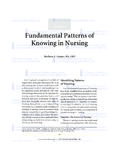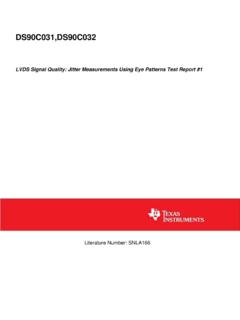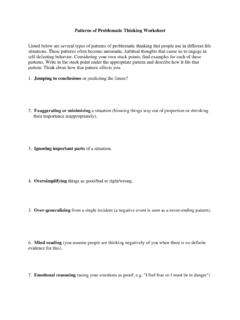Transcription of Weather Patterns and Seasonal Changes
1 Science Enhanced Scope and Sequence Grade 1 virginia department of education 2012 1 weather patterns and seasonal changes Strand Earth Patterns , Cycles, and change Topic Weather Patterns and Seasonal Changes based on temperature, light and type of precipitation. Primary SOL The student will investigate and understand Weather and Seasonal Changes . Key concepts include b) there are relationships between daily and Seasonal Changes ; c) Changes in temperature, light, and precipitation can be observed and recorded over time. Related SOL The student will demonstrate an understanding of scientific reasoning, logic, and the nature of science by planning and conducting investigations in which b) observations are made from multiple positions to achieve a variety of perspectives and are repeated to ensure accuracy; d) simple tools are used to enhance observations; e) length, mass, volume, and temperature are measured using nonstandard units; f) inferences are made and conclusions are drawn about familiar objects and events; g) a question is developed from one or more observations; h) predictions are made based on Patterns of observations.
2 I) observations and data are recorded, analyzed, and communicated orally and with simple graphs, pictures, written statements, and numbers. Background Information Earth's seasons are not caused by the differences in the distance from the Sun throughout the year. The seasons are the result of the tilt of Earth's axis. Earth's axis is tilted and this tilting is what gives us the four seasons of the year spring, summer, autumn (fall) and winter. During summer in virginia , the Northern Hemisphere of Earth is tilted toward the sun, causing more direct sunlight. As the Earth revolves around the sun, the Northern Hemisphere tilts away from the sun, causing indirect rays, and it is winter. Misconceptions occur when students are taught that the "day is shorter" in the winter.
3 The day is still 24 hours long; it is the amount of sunlight that is less. (For further information, search the Internet for information on What causes seasons. ) Science Enhanced Scope and Sequence Grade 1 virginia department of education 2012 2 Many plants and animals take advantage of the changing seasons, so that they grow during the summer when there is more sunlight available and they hibernate or stay in the form of seeds during the winter when there is less sunlight. Materials Daily Weather chart (attached) Weather Exploration sheet (attached) Student journals Magnifying glasses (optional) Large brown paper bag Objects to put in the bag that represent the seasons 3x5 blank notecards Crayons and markers to decorate Vocabulary Temperature, rain, snow, ice, seasons, autumn (fall), winter, spring, summer, Weather Student/Teacher Actions (what students and teachers should be doing to facilitate learning) Introduction 1.
4 Tell the students that they are going to take a Weather walk today. On that walk they are going to use their senses to make observations about the Weather and about how plants and animals are responding to the Weather . Tell them that they will want to be quiet which would increase the likelihood of seeing animals on the walk. 2. Give each student the Weather Exploration sheet to use to record what they observe on the walk. Review the sheet with them before you go out so they know what kinds of things they will be looking for on their walk. Explain that on this walk they will just be observing, not collecting items. (If you have them available, you might want to give students magnifying glasses.) 3. Ask students to predict what they think they might see, hear, and feel on their walk.
5 Procedure 1 4. Take the students outside for their Weather walk. 5. Encourage students to record what they are seeing, hearing, and feeling. 6. When you return to the classroom, gather in a large group. Give students the opportunity to share what they recorded. Especially encourage students to talk about the temperature outside, whether or not it was sunny, cloudy, windy, etc., and how they need to be dressed for the Weather . 7. Discuss the plants and trees they saw. Talk about how the growth of the trees and plants was affected by the Weather today. Science Enhanced Scope and Sequence Grade 1 virginia department of education 2012 3 8. Discuss any animals that were seen or any evidence of animals that was seen. Talk about what the animals were doing and how the Weather affected what they were doing.
6 Procedure 2 9. Collect the Weather daily. During this lesson, let each student record the Weather on a Weather chart (attached). 10. Discuss the types of Weather students are seeing and feeling. Begin to look for trends. Procedure 3 11. Explain to the students that for the next few days they are going to be Weather detectives. 12. For each of the next four days (or for the next four weeks), do the following: a. Pick a season of the year that will be the focus for the day or for the week. b. Place items in a large brown paper bag that relate to that season. (Examples for winter might be mittens, a small tree branch with no leaves, a picture of a bear hibernating, etc.) c. Have the students gather as a large group. Discuss that the items in the bag represent a season of the year.
7 Explain to the students that they need to be science detectives to help determine which season of the year we will be talking about today. d. Take out one item at a time and discuss what they see and feel. Tell them to begin to determine which season we are discussing today, but also tell them NOT to name the season yet. With each item, discuss what they see and what kind of Weather might be present with that item. ( , a bare tree limb might indicate that the temperature is cold.) e. After you have shown all the items in the bag, have students work with a partner to discuss quietly what season they think we are exploring today and why they think that. f. Give teams the opportunity to share their predictions about which season is being explored and have them give reasons why they have made that prediction.
8 G. Have students return to their seats and record in their journals what season they think is being discussed, making sure they explain the evidence for why they picked the season that they did. h. To extend the study of the season for the day, other activities during the day can be focused on that season. ( , Have students use winter objects such as snowballs or hats as the manipulatives for mathematics, read stories about winter, pretend to dress for the season to go outside or to lunch, etc.) i. At the end of the day, have each student make a season postcard. (3x5 note cards are good for making the postcards.) Have students decorate the front of Science Enhanced Scope and Sequence Grade 1 virginia department of education 2012 4 the card with a picture that shows the season of the day.
9 (They could draw a picture of it snowing and children making a snowman for winter.) On the back of the card, have students write a message to their parents telling them about the season and what they are doing that day during that season, what the schoolyard would look like during that season, and what animals ( , squirrels, ants, etc.) might be doing. To finish the postcard, students can draw a pretend stamp of their postcard and add an address for their parents. Procedure 3 13. Review the four seasons and how plants, animals, and people change and adapt for the seasons. Discuss what the Weather is like during each season. 14. Create a class bulletin board of the four seasons. Have students draw people, animals, and plants to decorate each season.
10 Assessment Questions o Describe the Weather for each season. Describe how the Weather affects the plants, animals, and people during each season. Journal/Writing Prompts o Pick your favorite season. Write about your favorite season. Why is it your favorite? Tell about the Weather during your favorite season. Tell about the things you like to do during that season. Describe the plants and animals and what they do during your favorite season. Other o Build a diorama of your favorite season. Extensions and Connections (for all students) Pick an animal or a plant. Track what the animal or plant you pick will look like and what it will do across the four seasons of a year. Explain why the animal Changes how it looks or what it does related to the Weather of the season.


















